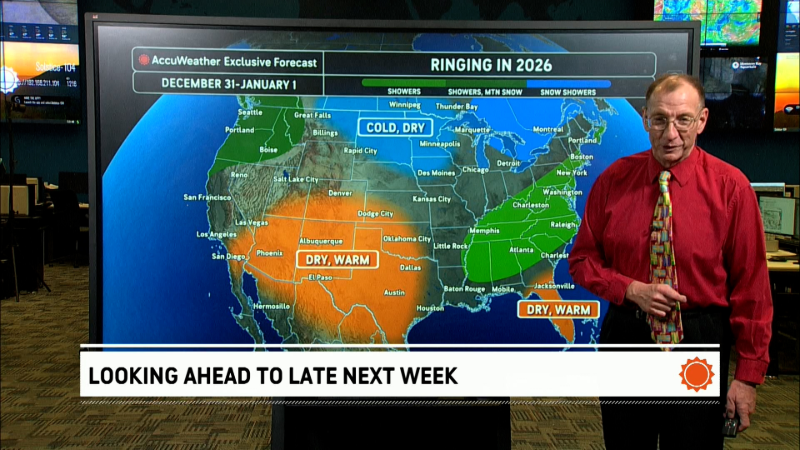In-depth analysis of US hurricanes: Which states are hit most frequently by devastating storms?
According to data from the National Hurricane Center (NHC), about 36 hurricanes have hit the U.S. from 1995 to 2017, 13 of which have been considered major hurricanes, or a Category 3 or above, at the time when they made landfall.
With the warming of the oceans, powerful hurricanes may be more frequent.
"A lot of scientists believe that if the oceans continue to warm, that with that warm water, you're going to have more powerful hurricanes," said AccuWeather's Hurricane Expert Dan Kottlowski. "And of course, that means the opportunity for one of these powerful hurricanes to hit the United States."
Hurricanes Maria, Harvey and Irma all hit the United States and Puerto Rico, respectively, as Category 4 hurricanes when they made landfall. The last hurricane of that category to make landfall on U.S. at that level was Hurricane Charley in 2004 according to NHC. Hurricane Katrina had made landfall as a Category 3 hurricane in 2005.

This Sept. 10, 2017 file photo shows waves crashing over a seawall at the mouth of the Miami River from Biscayne Bay, Fla., as storm surge from Hurricane Irma impacts Miami. (AP Photo/Wilfredo Lee)
Hurricane season lasts from June 1 to Nov. 20. Kottlowski notes the most dangerous time of the season as mid-September, specifically Sept. 10, as it is the peak of hurricane season.
From 1995 to 2017, the highest number of tropical systems, including tropical depressions, tropical storms and hurricanes combined at 112 occurrences of the 268 noted systems to have made landfall on U.S. soil happened in the month of September. The month also had the most amount of hurricanes individually, amounting to 16, about 44 percent of the hurricanes in that time span.
Kottlowski explains warmer water at this time plays a role in the peak in the season. At this time of the year, there is less wind shear. Without the wind shear, there's more opportunity for a hurricane to develop, and warmer ocean waters only help to increase that.
Hurricane Harvey, Irma and Maria all happened at the end of August or mid-September; Irma made landfall in Florida exactly on Sept. 10.
The Congressional Budget Office (CBO) estimates the expected annual damage cost to the states overall to currently amount to about $28 billion. Florida accounts for the largest share of expected damage cost at 55 percent in the agency’s calculations. Overall, that’s about $15.4 billion worth of damage to the state each year. CBO estimates the expected cost to rise to about $21.5 billion for Florida by 2075 taking into account both climate and development changes along the coasts.
Of the 36 hurricanes, 11 have directly hit Florida, making it the state with the most direct hits from hurricanes in the United States according to information from the National Hurricane Center. North Carolina follows Florida as the state with the most direct hits at seven hurricanes.
Despite this, North Carolina only accounts for 2 percent of the damage cost. Texas and Louisiana follow Florida in cost damage with 13 percent and 9 percent, respectively.
However, Florida as a peninsula is generally in the path of most hurricanes, while it's mostly the Outer Banks of North Carolina that hurricanes catch when they sideswipe the state.
According to Kottlowski, it's the water from hurricanes that does the most damage when a hurricane hits.
"Flooding and storm surge by far causes more damage than wind does, collectively," said Kottlowski. "The wind problem is more of a localized-type situation."
Kottlowski explained the diameter of the hurricane will deliver the wind damage. The bigger and more powerful the hurricane, the more wind damage the hurricane causes, bringing greater storm surges along with it.
"More people die from water than they do from wind," said Kottlowski.
The more powerful storms, according to Kottlowski, tend to be the Cabo Verde storms, or the hurricanes that form from off the coast of Africa and travel across the Atlantic, gaining momentum as they travel over warmer water for a long distance.
"Cabo Verde hurricanes are much more powerful hurricanes and ones that just develop and develop," said Kottlowski.
Hurricane Maria, Irma and Harvey were all Cabo Verde hurricanes.
While the Cabo Verde storms may pack a punch, they generally move on quickly. The ones that form in the Gulf of Mexico, however, tend to move much more slowly, causing more devastation according to Kottlowski, as they generate more rainfall.
Hurricane Harvey showed the worst of a slow Cabo Verde storm, even stalling in its travels and flooding Houston and other parts of Texas.
According to the NOAA National Centers for Environmental Information (NCEI), the damage from Hurricane Harvey is estimated to cost $126 billion. Maria's costs are estimated $90 billion and Irma's at $50 billion, according to NCEI. Only Hurricane Katrina caused greater monetary damage at $163 billion in 2018 USD.
Report a Typo











